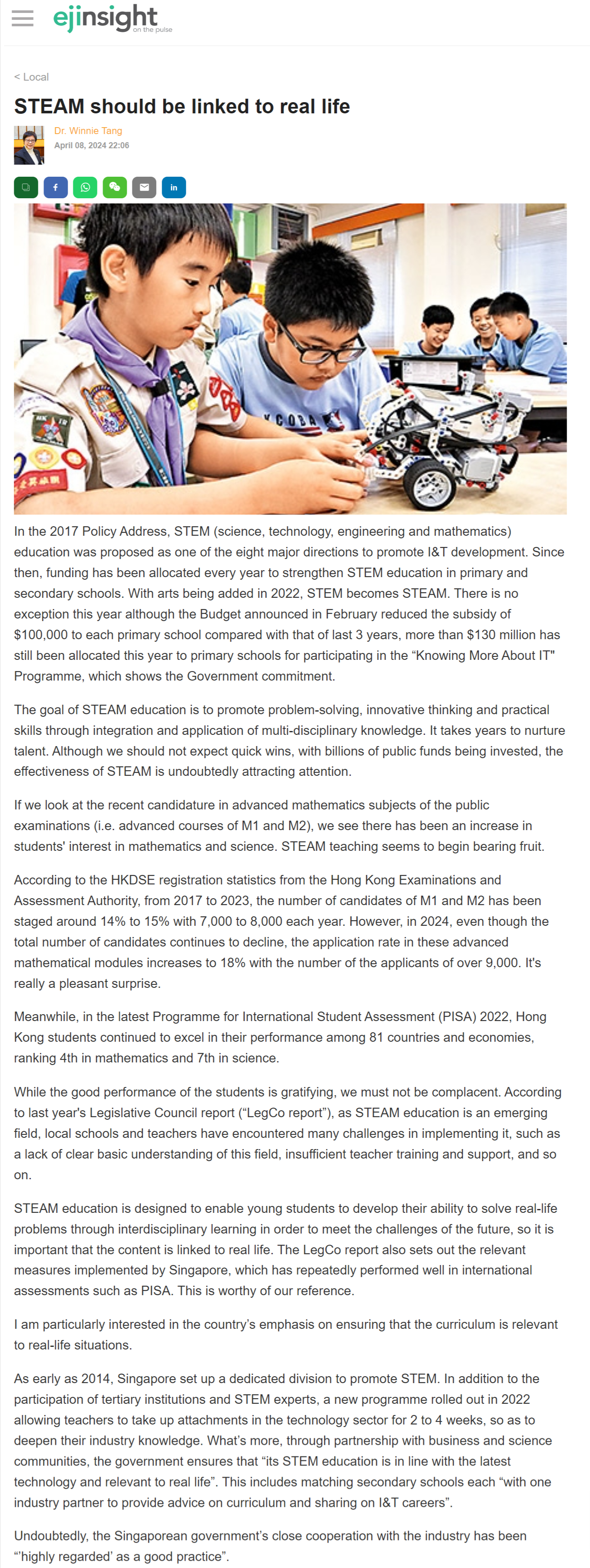網上版請按此

STEAM should be linked to real life
In the 2017 Policy Address, STEM (science, technology, engineering and mathematics) education was proposed as one of the eight major directions to promote I&T development. Since then, funding has been allocated every year to strengthen STEM education in primary and secondary schools. With arts being added in 2022, STEM becomes STEAM. There is no exception this year although the Budget announced in February reduced the subsidy of $100,000 to each primary school compared with that of last 3 years, more than $130 million has still been allocated this year to primary schools for participating in the "Knowing More About IT" Programme, which shows the Government commitment.
The goal of STEAM education is to promote problem-solving, innovative thinking and practical skills through integration and application of multi-disciplinary knowledge. It takes years to nurture talent. Although we should not expect quick wins, with billions of public funds being invested, the effectiveness of STEAM is undoubtedly attracting attention.
If we look at the recent candidature in advanced mathematics subjects of the public examinations (i.e. advanced courses of M1 and M2), we see there has been an increase in students' interest in mathematics and science. STEAM teaching seems to begin bearing fruit.
According to the HKDSE registration statistics from the Hong Kong Examinations and Assessment Authority, from 2017 to 2023, the number of candidates of M1 and M2 has been staged around 14% to 15% with 7,000 to 8,000 each year. However, in 2024, even though the total number of candidates continues to decline, the application rate in these advanced mathematical modules increases to 18% with the number of the applicants of over 9,000. It's really a pleasant surprise.
Meanwhile, in the latest Programme for International Student Assessment (PISA) 2022, Hong Kong students continued to excel in their performance among 81 countries and economies, ranking 4th in mathematics and 7th in science.
While the good performance of the students is gratifying, we must not be complacent. According to last year's Legislative Council report ("LegCo report"), as STEAM education is an emerging field, local schools and teachers have encountered many challenges in implementing it, such as a lack of clear basic understanding of this field, insufficient teacher training and support, and so on.
STEAM education is designed to enable young students to develop their ability to solve real-life problems through interdisciplinary learning in order to meet the challenges of the future, so it is important that the content is linked to real life. The LegCo report also sets out the relevant measures implemented by Singapore, which has repeatedly performed well in international assessments such as PISA. This is worthy of our reference.
I am particularly interested in the country's emphasis on ensuring that the curriculum is relevant to real-life situations.
As early as 2014, Singapore set up a dedicated division to promote STEM. In addition to the participation of tertiary institutions and STEM experts, a new programme rolled out in 2022 allowing teachers to take up attachments in the technology sector for 2 to 4 weeks, so as to deepen their industry knowledge. What's more, through partnership with business and science communities, the government ensures that "its STEM education is in line with the latest technology and relevant to real life". This includes matching secondary schools each "with one industry partner to provide advice on curriculum and sharing on I&T careers".
Undoubtedly, the Singaporean government's close cooperation with the industry has been "'highly regarded' as a good practice".
Dr. Winnie Tang
Adjunct Professor, Department of Computer Science, Faculty of Engineering; Department of Geography, Faculty of Social Sciences; and Faculty of Architecture, The University of Hong Kong